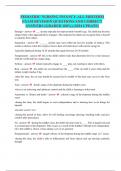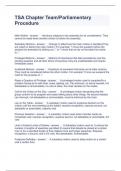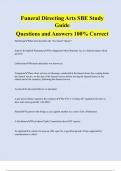PEDIATRIC NURSING INFANCY. ALL MIDTERM
EXAM REVISION QUESTIONS AND CORRECT
ANSWERS (GRADED 100%) (2024 UPDATE)
Stranger - answer- ___ anxiety typically develops around 8 month's age. The child may become
clingy/whiny when approached by strangers. This indicates the infant can recognize him or herself
as separate from others.
Separation - answer- -______ anxiety may start within the last few months of infancy. This
results in distress when the caregiver leaves then will calm down with current caregiver.
-typically displayed during 18-24 months then again between 24-36 months
Temperament - answer- this is the child's inborn traits that determine how he or she interacts
with the world and has a large range.
Solitary - answer- infants typically engage in ____ play, not wanting to share with others.
Rear - answer- -the infant car seat should face the ____ of the car until 2 years when and the
infants weight reaches 9 kg.
-after this time, the car seat should be secured int he middle of the back seat, never in the front
seat.
Anal - answer- -freud's stage of development during the toddler years
-focus is on achieving anal sphincter control and the child is learning to toilet train
Autonomy vs. Shame and doubt - answer- -erikson's stage of development during the toddler
years
-during this time, the child begins to exert independence and is learning how to do things for
himself
-favorite word is "no."
-during this period of time, allow for self feeding, encourage dressing, brushing teeth, and give
comfort after procedures.
No - answer- -during the toddler years, the child's favorite word is ____. This is negativism and
is a normal part of development. This occurs as a result of the toddler's attempt to be independent.
Give the toddler a choice versus asking a yes or no question.
Preoperational - answer- -piaget's theory of development during the toddler stage. (2-7 years)
-during this time, the child is able to differentiate self from objects and can develop symbolic
thought
,-the child can use all senses, play begins to become more complex, imitation and animism
(attributing human feelings to objects, this is also seen in the preschooler years) are displayed
Growth spurts - answer- -during the toddler years, height and weight changes occur in ____
____
3-5 - answer- during the toddler years, the average weight gain is ____ pounds per year.
3 - answer- -during the toddler years, the average height gain is ___ inches per year and they
reach half of their adult height by 2 years.
-the head is more proportional to the body by age 3.
2 - answer- the head circumference reaches about 90% of it's adult size by __ years of age
7 - answer- alveoli continue to increase in number as growth continues, and do not reach adult
numbers until approximately ___ years
16-24 - answer- bladder and kidney function reach adult levels by ____ months
Potbelly - answer- the toddler typically has a ___ until approximately 3 years, then the
musculature strengthens and belly flattens.
Physiologic anorexia - answer- -during the toddler years and in between growth spurts, _____
____ may be displayed because the toddlers won't be as hungry.
-during this time it's important to try to prevent overweight and child obesity by feeding them
nutritiously. Fat and cholesterol should be restricted.
500 - answer- -a toddler requires ___ mg. Of ca per day.
-one cup of milk, 8 oz. Of yogurt, and 1.5 oz. Of cheese provide about 300 mg.
-other sources include broccoli, oranges, sweet potatoes, tofu, dried beans, and legumes.
4-6, 16-24 - answer- juice intake should be limited to ___ oz. And milk intake should be limited
to ___ oz. During the toddler years.
3, 2 - answer- the toddler typically eats ___ meals per day with __ snacks
Self feeding - answer- -during the toddler years, promote ___ ___ by using child size utensils,
seat them in high chairs, never leave them unattended, and minimize distractions
-offer a variety of foods at each meal.
-avoid using food as a reward or punishment
,-encourage water rather than sweet drinks or fruit juice.
Toddlers are not growing as fast so there will be times when she is not hungry - answer- the
nurse is providing nutrition advice to a mother of a 2 year old. Which of the following provides
the best advice?
Low fat yogurt, whole or low fat milk, broccoli - answer- which of the following are the best
sources of ca for a toddler diet?
Raisins, beans, whole grains - answer- a mother reports that her 2 year old will not eat meat.
Which of the following are plant sources of iron that you can recommend?
12-15 - answer- -by ____ months age, the child can make 2 similar sounds like "da-da"
-walks independently and has a characteristic toddler's gait.
-picks up strings, uses pincer grasps, feeds self, throws ball, stacks blocks, turns pages of book,
drinks from cup, helps with dressing, can button and zip, use utensils
-claps 2 toys together, looks for hidden objects, dumps things out of containers, copies single line
drawings
-pulls on hand or clothes for attention, comes to you for help
Developmental screening - answer- -recommended for every child 5 and younger which
screens for developmental, emotional, and behavioral problems
-over 25% of children are at risk
-focuses on the positive development and helps to identify children with delays or problems early
in life
Running, jumping, hitting - answer- common displays of emotion for a toddler
Egocentrism - answer- -common social/emotional development milestone displayed in the
toddler and preschooler years.
-defined as the need to feel in control of his or her own world
-the child will approach problems from a single point of view.
24 months - answer- -by ___ age, the child can point to correct pictures in a book, imitate a 2
word sentence, follow directions, walk down stairs with rails, kick large balls, run, jump, use spoon
without spilling, drink from cup without spilling, turn page of book, stack blocks, copy line
drawings, use pretend play, and comb hair.
50 - answer- by age 2, the toddler begins to use short words and sentences. Vocab progresses
to approximately ___ words.
, Hep. B, hib 4, ipv 3, mmr, varicella, pcv, influenza, hep a - answer- toddler required
immunizations within first 12-15 months
Hib 4, pcv4, ipv 3, dtap 4, hep b, mmr, varicella, hep a - answer- toddler immunizations required
within first 15-18 months
13.5 - answer- the 18 month old requires ___ hours of sleep per day
13 - answer- the 24 month old requires ___ hours of sleep per day
12 - answer- the 3 year old requires ___ hours of sleep per day. The toddler should sleep through
the night and take on daytime nap. Bedtime rituals are very important.
Bottles or cup that requires sucking - answer- -it should be recommended to the parents of a
toddler not to use __________ by 15 months which can increase risk of problems with dental
health.
-dentist should be visited by age 1 year
Parallel - answer- -toddler typically engage in ____ play.
-this is defined at playing alongside others but independently rather than cooperatively
Fluorosis - answer- -excess fluoride ingestion during the toddler years can lead to ____.
-avoid foods such as tea, ready to eat infant foods with chicken, grape juice, processed foods, and
cereals.
Discipline - answer- -promoting appropriate discipline includes the following:
-physical punishment is not recommended
-decrease risk of harm, encourage safety and child exploration
-keep rules simple, and give toddler a choice.
-use positive reinforcement.
-time out can start being used by 2-3 years.
Preschooler - answer- -physical growth during the ___ period (3-6 years) is much more slow
while cognitive growth continues to increase.
-most organ systems have matured by this age.
Phallic - answer- -freud's theory of development during the preschooler years.
-during this time, be sensitive to comfort level with male or females, encourage parent involvement
-the child's pleasure centers around the genitalia and conscience is developing.
-the superego/sense of guilt is completed during this period.






